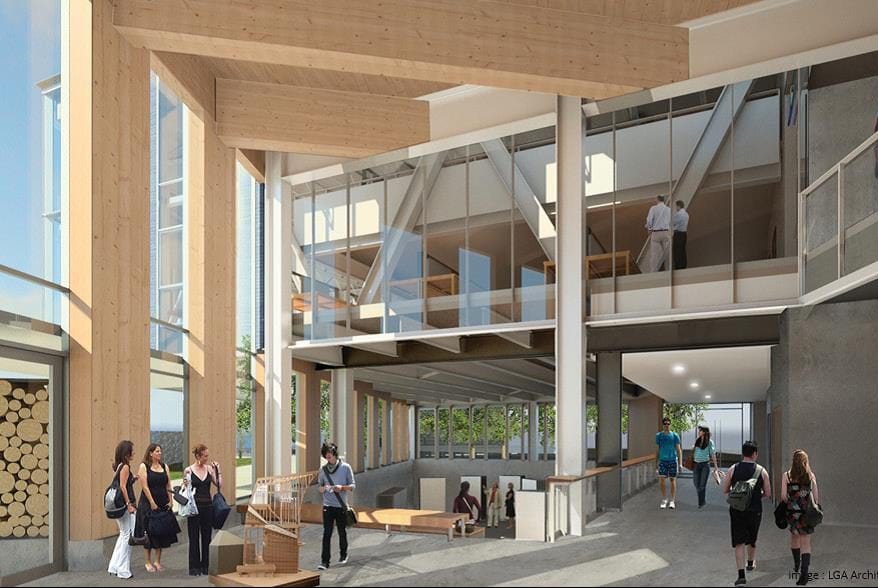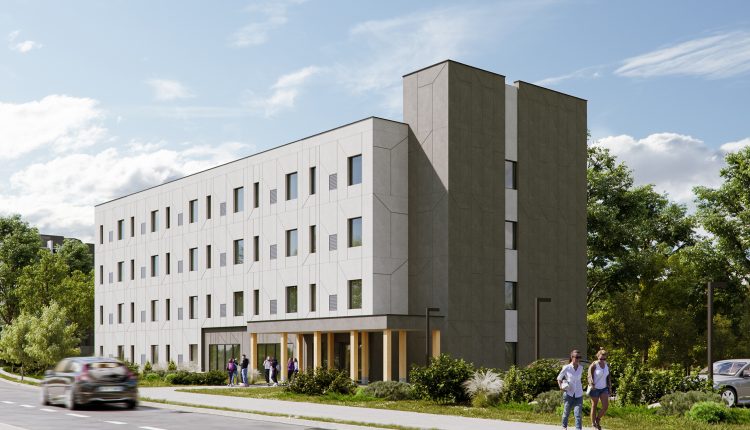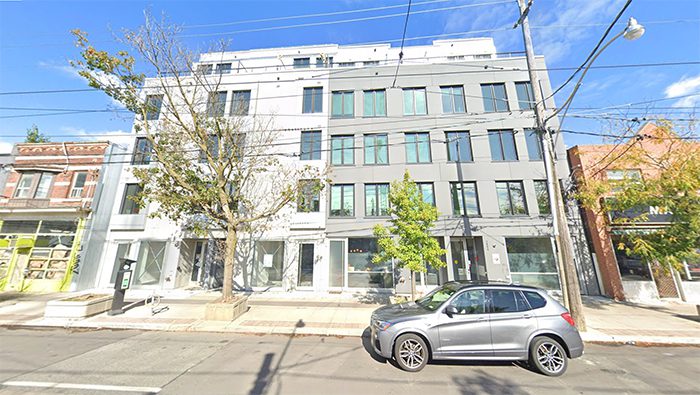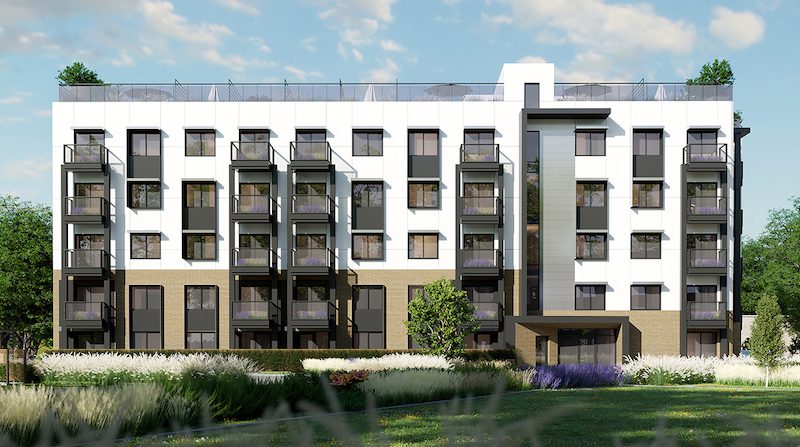Acoustic Design Strategies for Mass Timber Buildings
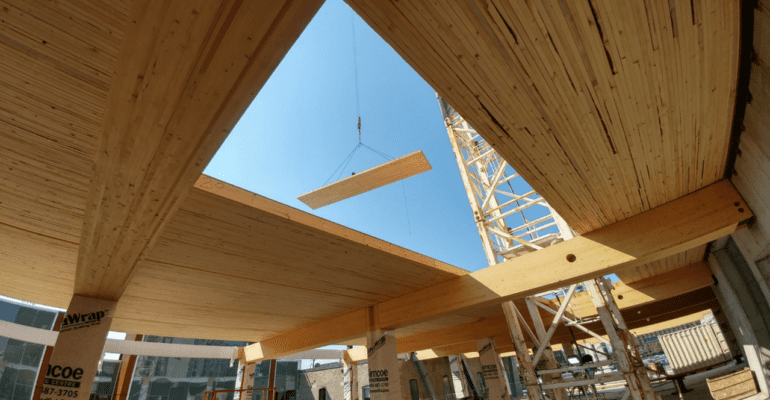
Mass Timber and Acoustics: Answering Common Questions
Mass timber has been gaining significant traction in recent years as a sustainable and aesthetically pleasing alternative to traditional building materials like steel and concrete. While its environmental benefits and visual appeal are widely discussed, there’s another aspect of mass timber construction that often is overlooked, or worse, concerning to architects and developers: its acoustics. As acoustical consultants, we’d like to answer some of the most common questions we hear about mass timber acoustics and how it impacts the built environment.
What is Mass Timber, and Why Is It So Popular?
Mass timber is a collective term for large, solid wood structural panels used in construction. The most common types of mass timber include cross-laminated timber (CLT), dowel-laminated timber (DLT), nail-laminated timber (NLT), and glue-laminated timber (glulam). The surge in its popularity can be attributed to several factors:
Sustainability: Mass timber is sourced from sustainably managed forests and has a lower carbon footprint compared to traditional building materials. It is estimated that 1 m3 of mass timber sequesters approximately
1 metric ton of CO2.
Aesthetics: The natural beauty of wood lends warmth and character to spaces, making it an attractive choice for architects and designers. Research has shown that exposed wood has correlated with psychological and physical health benefits.
Speed of Construction: Mass timber is prefabricated and can be assembled quickly, reducing construction time. A recent 5-storey mass timber project of ours was erected in only 2-3 months!
How Does Mass Timber Impact Acoustics?
Mass timber’s acoustic properties are different than those of traditional building materials like steel and concrete. Understanding these differences is critical when designing comfortable and functional indoor environments.
Direct Sound Transmission:
Mass timber can require additional insulation or acoustic treatments to block direct sound effectively. Often this can be done on the floor side of the mass timber panels with either wet materials (e.g., concrete, gypcrete, etc.) or dry (e.g., thin secondary CLT panels, plywood, proprietary materials, etc.), typically isolated from the mass timber with rubber, and separated at the suite-demising wall boundaries. Direct sound transmission can be addressed through the wall by either protecting the mass timber wall panels with insulated partitions, or installing exposed double CLT wall panels, separated by an insulated air gap.
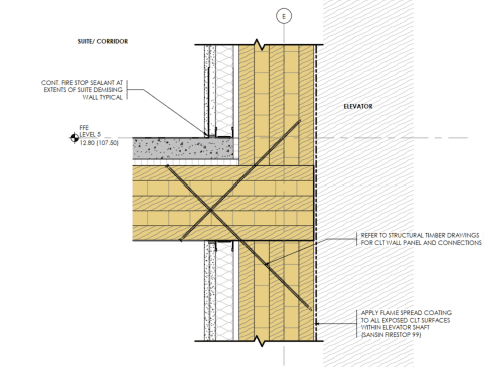
Indirect Sound Transmission:
Decoupling of mass timber panels allows for the introduction of acoustical controls at the panel junctions, with less pressure for isolating sound and vibration directly at the source; this can be particularly useful in challenging environments, such as addressing sound transmission through the CLT ceiling panels between a mechanical room (where piping and ductwork can make building a ceiling difficult) and an adjacent suite. While a concrete building would require protection of the concrete ceiling slab in one or both spaces, CLT ceiling panels isolated at the demising junction allows for keeping the CLT exposed in both rooms, increasing ceiling height and avoiding conflicts with piping, ductwork, and other services.
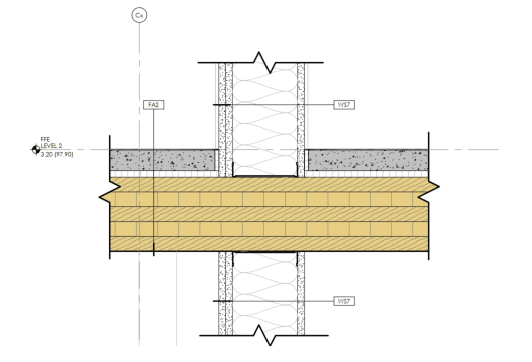
Sound Absorption:
We often get calls regarding excessive reverberation leading to very high sound levels in meeting rooms, schools (particularly gymnasiums) and event spaces, often due to exposed concrete finishes. Mass timber can alter the acoustics of a space differently than concrete and may lend itself aesthetically to the addition of acoustic treatments (i.e. perforated wood, slats, etc.,).

How Does Mass Timber Compare to Other Building Materials in Terms of Acoustics?
Mass timber’s acoustic properties, briefly introduced above, can be quite different than those of steel and concrete. Here’s a brief comparison:
Airborne Sound Transmission:
Mass timber generally provides similar airborne sound insulation performance compared to other wood joist or composite steel deck structures (which often require isolated ceilings below). Concrete can outperform mass timber structure with respect to direct airborne sound transmission unless a dropped ceiling is included below the timber panels.
Impact Noise:
Mass timber, like wood joist, steel deck, and concrete structures, can be prone to impact noise, like footsteps or falling objects. Steel deck and concrete structures typically require acoustical flooring underlayments to address high frequency impact noise (e.g., from hard-soled shoes), and without these underlayments, high frequency impact noise can be quite significant. Mass timber and wood joist structures with isolated floor toppings are generally better at addressing high frequency impact noise but are prone to low frequency impact concerns (e.g., thumping from heavy walking); heavy secondary floor toppings (e.g., concrete) or upgraded floor topping isolation can improve this impact sound transmission performance across the frequency spectrum.
Resonance:
Mass timber’s resonance characteristics may need special consideration during design and construction to prevent sound amplification, particularly from synchronized aerobic activities (such as dance classes).
What Are Some Design Strategies for Optimizing Mass Timber Acoustics?
To optimize mass timber acoustics, we recommend that architects and developers consider the following design strategies:
Acoustic Design:
Early collaboration with acoustical consultants is essential to design spaces that meet acoustic goals. Proper coordination of mass timber panel layouts, isolation of structural connections, and secondary architectural controls can enhance the acoustic experience.
Acoustic Insulation:
Careful attention to not only the demising wall and floor constructions, but also the junction details, and room layouts can improve sound isolation. Special consideration of these things can allow for sought after exposed CLT ceiling finish, particularly most challenging (but certainly possible) to achieve in residential projects.
Surface Treatments:
Applying finishes that reduce sound transmission and enhance sound absorption, like gypsum protection of structural elements and installation of perforated wood panels, can further improve the acoustic environment.
Structural Considerations:
Adjusting timber thickness or using damping materials can mitigate resonance issues in mass timber structures.

